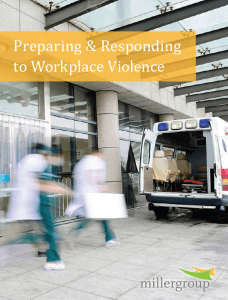Building a Response Program for Workplace Violence
August 2, 2022
Learn the keys to building a response program to prepare and respond to workplace violence from Director of Safety Aaron Paris.
Learn the keys to building a response program to prepare and respond to workplace violence from Director of Safety Aaron Paris.

We see a lot of news coverage about shootings and violent acts, especially when such events happen at churches and schools. Yet businesses are at a significantly higher risk for active violence. In fact, workplace violence is in the top four leading causes of workplace deaths according to the Bureau of Labor Statistics.
In 2020 alone there were 20,050 injuries and 392 fatalities attributed to workplace violence. You always hope such an event will never happen at your business, and some may believe the chances are slim. Yet it is vital to remain proactive and create a safety plan should an incident take place. Here are elements to consider as you craft your company’s response program.

There are four types of workplace violence that businesses should consider
when building their response program:
Businesses should have a standing policy and procedure for workplace violence.
The policy should detail the following:
In the event an incident occurs, business interruption is highly likely. Planning for such interruptions will provide businesses a clearer path in an uncertain time.
Identify contingencies for:
Educate employees on how to respond to an event and where emergency exit routes are located. Employees should respond in one of three ways:
Run
Hide
Fight
Calling 911 and giving them as much information as possible is critical for an appropriate response. Provide what you know. The “who, what, when, where and how” model works best in giving the most concise and important information.
Unlike fires and other emergencies, meeting at the front of the building may not be advisable. Finding a location close but offsite may be a better solution.
Consider designating a company representative to coordinate with law enforcement and EMS onsite. Choose someone who maintains calm under extreme stress.
A location for families of those affected in the event to get answers to their questions.
Provide a separate area for family of deceased victims to grieve in privacy and serve as a shield from media.
Information and resources to share include: